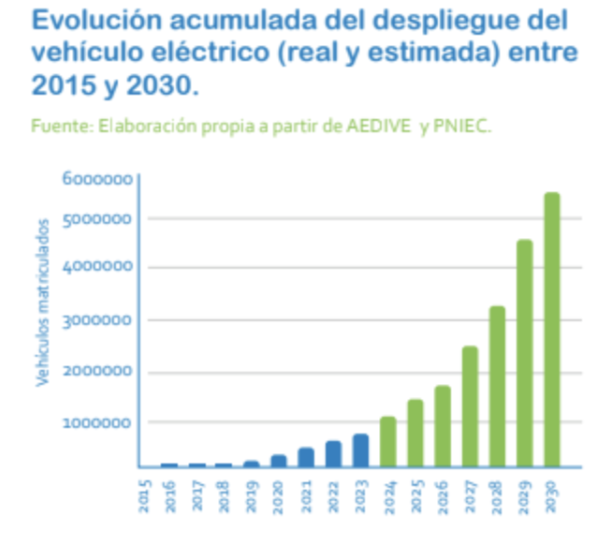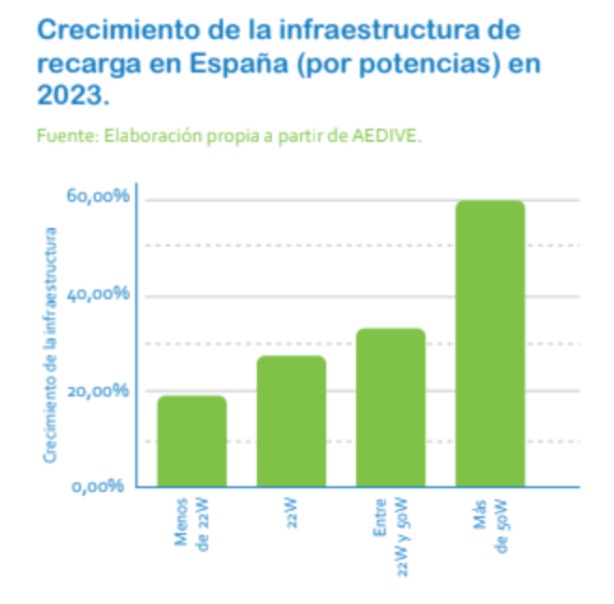The Business Association for the Development and Promotion of Electric Mobility (AEDIVE) has recently released the document “Proposals for an electric mobility roadmap.”
The file includes 18 measures to be implemented during the current legislative term to achieve the objectives of the National Integrated Energy and Climate Plan (PNIEC) and ensure the future of the mobility industry in Spain.
The general director of the business association, Arturo Pérez de Lucía, states: “In Spain, incentives for electric vehicles are more complex than in other countries, at a time when we should accelerate if we want to meet the objectives (of the PNIEC), which are not in line with current sales. This implies registering 12 times more vehicles in seven years than have been registered in the last 13 years.’
This roadmap comes after a record year.

2023 was the year with the highest number of electric vehicles sold in Spain, surpassing 70,000 registrations, double if we add plug-in hybrids.
With these numbers, Spain is the second-largest power in the European Union in terms of the growing number of people opting for electric vehicles.
Charging points also increased more than ever last year.

In 12 months, almost one in three operational public charging points was installed, now totaling more than 30,000 across the country.
Specifically, in the last year, 8,777 were installed, nearly one-third of all currently operational points.
This represents an increase of 40.7 percent compared to the data from the end of 2022.
AEDIVE celebrates these figures, though they emphasize the need to accelerate sales further to meet national goals, which the government updated last June in the PNIEC review, setting a target of 5.5 million electrified vehicles on our roads by 2030.
It will also be necessary to publish updated information on public charging points, including their number, power, and usage time, to verify if the installed points are still sufficient to supply the fleet.
It is worth noting that users are still awaiting the National Charging Points Map promised by the government.
Roadmap proposed by AEDIVE
The strategy published by AEDIVE proposes increasing ambition with measures agreed upon with the sector, easy to implement, and successfully tested in leading European countries in electric mobility.
In the short term, the association advocates for a new MOVES Plan that includes an advance in incentives for buyers and for streamlining the processing of charging infrastructure, especially for fast and ultra-fast charging.
In the medium term, it is proposed to accompany the incentives with a fiscal shock plan, including improvements in VAT, Corporate Tax, and Vehicle Registration Tax to make electric cars affordable for all budgets.
It also suggests deploying measures to promote new shared mobility models at the local level, after exceeding six million uses in different applications in 2023.
In addition to promoting the electrification of the taxi fleet, accompanied by a greater deployment of public fast-charging infrastructure.
In the long term, the sector has its sights set on the major challenges of the legislative term.
It proposes to place electrification at the center of the new Sustainable Mobility Law, which the Minister of Transport recently announced would restart its processing in February.
Recently, the Minister of Transport and Sustainable Mobility, Óscar Puente, announced the decision of the Council of Ministers to resume the project, with the expectation of its approval next month.
He also emphasized the commitment to the European Union for its entry into force before the end of the year.
It also advocates for the strengthening of the national industry in the face of ambitious aid plans and the recent success of Asian and American models.
Therefore, it also suggests deploying an electric mobility plan for the business sector that encourages the electrification of the corporate fleet through annual progressive goals and plans for employees.
An industry that goes beyond borders
The sector is increasingly betting on Spain and expects to generate over 300 billion euros in revenue by 2030, more than 40 billion euros each year.
The country boasts nearly a hundred manufacturing centers in Spain, in addition to various announced projects.
In certain activities, such as the production of charging points, it is considered “the main exporting power in the European Union.”
“If the right incentives are deployed, Spain aspires to become the European hub for electric mobility, with domestic green tech companies that could create over 250,000 direct and indirect jobs in the coming years,” he assures.
In this regard, Arturo Pérez de Lucía states, “It’s not just about registrations; in Spain, we must highlight that we have an industrial capacity that other countries do not possess.”
“We manufacture all types of vehicles, all kinds of charging infrastructure, or components and technological solutions for energy storage. Therefore, we have an ecosystem that makes us particularly unique,” he adds.
Not only that, but AEDIVE emphasizes the importance of considering the electric vehicle as much more than an instrument for decarbonization and pollution reduction in mobility.
It is also a fundamental axis of energy efficiency, being the only propulsion system capable of interacting with the electrical system to promote renewable energies, distributed generation, and energy storage.
Road transport in Spain accounts for a consumption of over 300 TWh, which could be halved by electrifying the vehicle fleet, using renewable and indigenous energy sources.
With the current fleet, there is absolute dependence on other countries for the purchase of fossil fuels.
“This makes us very vulnerable from an economic, energy, and geopolitical perspective in an increasingly complex world, where the key is to achieve greater self-sufficiency,” says Pérez de Lucia.
Electric trucks
By 2024, the sector expects significant advancements in the electrification of freight transport.
Major manufacturers have already started unveiling their first models of electric trucks.
The European Union has approved binding targets for the installation of charging points for heavy transport by 2030.
Therefore, AEDIVE urges the government not to be late in this transformation.
The Roadmap includes a Plan for Charging Infrastructure for Heavy Electric Vehicles (PIRVEP), with a set of ten proposals that have already begun to be worked on with the industry.
The next step will be to define regulatory measures for each point of the proposal that promote its compliance and will be available in the first part of the year.







